Nestled in Yamaguchi Prefecture, overlooking the scenic Nishiki River, Iwakuni Castle (岩国城, Iwakuni-jō) is one of Japan’s most picturesque historic sites. Although originally constructed in the early 17th century, the castle has a fascinating story of destruction, reconstruction, and preservation. Today, it attracts both history enthusiasts and travelers seeking panoramic views, cultural insights, and a glimpse into Japan’s feudal past.
A Brief History of Iwakuni Castle
Iwakuni Castle was built in 1608 by Kikkawa Hiroie, a retainer of the powerful Mōri clan. However, the castle was dismantled just seven years later under the Tokugawa shogunate’s “One Castle Per Province” law, which aimed to limit the power of regional lords.
The present-day structure is a reconstruction completed in 1962, designed to replicate the original architecture. Unlike many castles in Japan that stand in bustling city centers, Iwakuni Castle is perched on Mount Shiroyama (at 200 meters altitude), providing breathtaking views of the Nishiki River, Iwakuni city, and the iconic Kintaikyō Bridge, one of Japan’s most famous wooden arch bridges.
Highlights of Visiting Iwakuni Castle
1. The Scenic Ropeway Ride – Gateway to the Castle
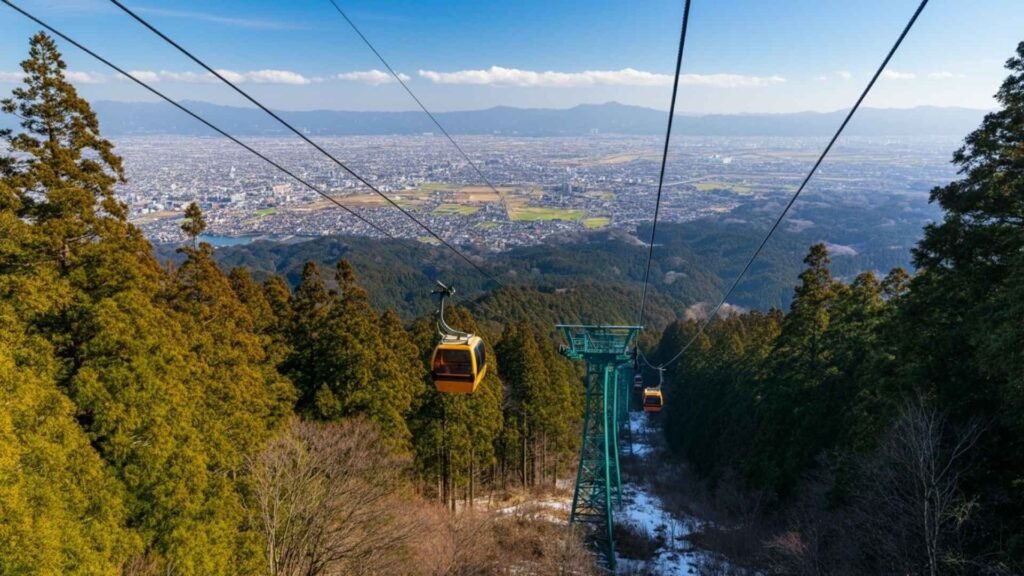
Reaching the castle is part of the adventure. Visitors begin their journey at the base of Mount Shiroyama, where the Iwakuni Ropeway ascends through lush, forested slopes. During the ride, sweeping views of Iwakuni city, the flowing Nishiki River, and the rolling mountains create a cinematic introduction to the site.
- Travel Tip: The ropeway ride takes only about 5 minutes, but it’s worth pausing at the top station to take photos before walking up the gentle path to the castle grounds.
- In spring, cherry blossoms line the hillsides, while in autumn, vibrant red and orange foliage sets the mountains aglow.
2. Inside the Castle Museum – Samurai Legacy Preserved
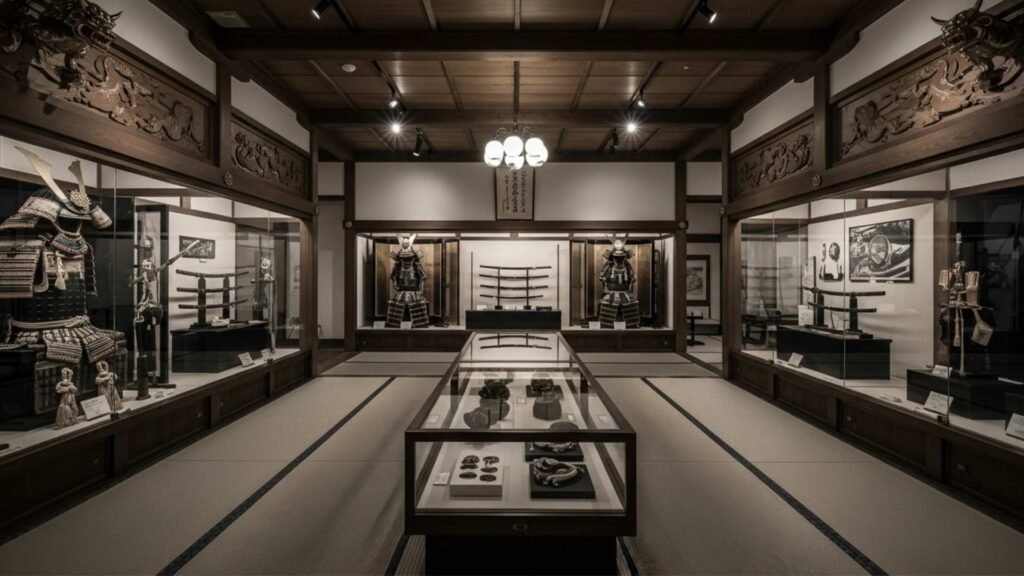
The original Iwakuni Castle was completed in 1608 by Kikkawa Hiroie, a retainer of the powerful Mōri clan. However, under Tokugawa rule, it was dismantled only seven years later. The present structure, reconstructed in 1962, stands as both a cultural landmark and a museum.
Inside, the Iwakuni Castle Museum houses a remarkable collection of samurai artifacts:
- Swords and armor: Finely forged blades and protective armor used by warriors of the Edo period.
- Documents and maps: Offering a glimpse into the political and military strategies of the Kikkawa family.
- Artifacts of daily life: Small items that reveal the blend of martial duty and refined culture that defined samurai households.
- Travel Tip: English descriptions accompany many exhibits, making it easy for international visitors to follow the history and significance of the collection.
3. The Panoramic Observation Deck – Views Worth the Climb
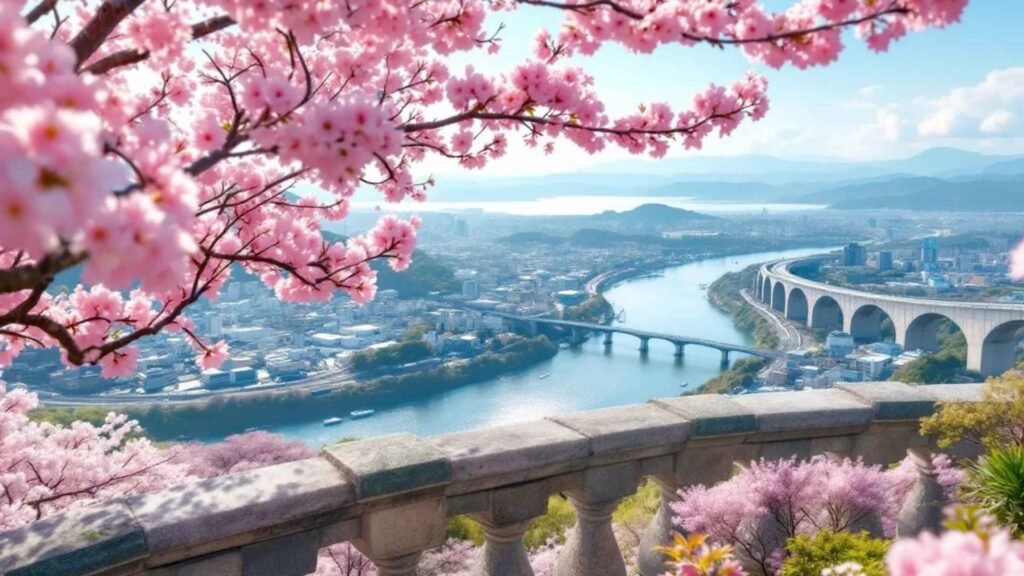
The castle’s top floor observation deck rewards visitors with breathtaking views. Looking outward, one can see:
- The city of Iwakuni, dotted with traditional houses and modern buildings.
- The graceful five-arched Kintaikyō Bridge, one of Japan’s most famous wooden bridges.
- The shimmering Seto Inland Sea in the distance, dotted with small islands.
The observation deck is especially enchanting:
- In spring, the landscape is painted with delicate cherry blossoms.
- In autumn, fiery red maple leaves and golden foliage stretch across the horizon.
- At sunset, the golden glow reflects off the river and the bridge, creating a magical scene for photographers.
4. Kintaikyō Bridge & Riverside Walks – A National Treasure
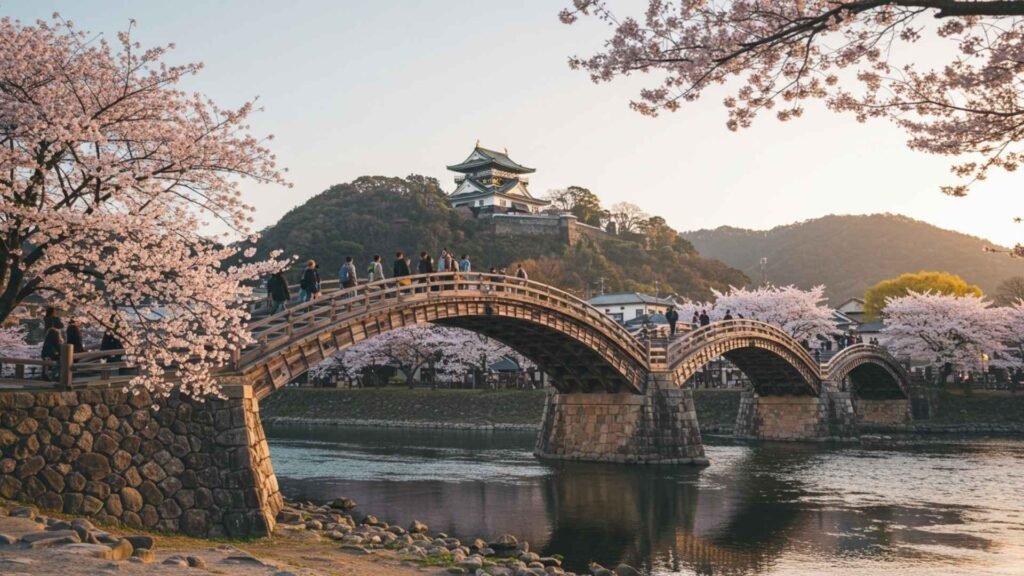
Below the castle lies one of Japan’s greatest architectural marvels: the Kintaikyō Bridge. Built in 1673, the bridge has been meticulously preserved and remains a national treasure. Its five elegant wooden arches span the Nishiki River without the use of nails, showcasing ingenious craftsmanship.
- Visitors can stroll across the bridge, feeling its gentle curves underfoot while enjoying panoramic river views.
- On the far side, riverside parks are perfect for picnics, seasonal festivals, and photography.
- From the riverbanks, it’s possible to capture both the bridge and the castle above—an iconic Iwakuni scene.
- Travel Tip: Visit during the Kintaikyō Cherry Blossom Festival in spring or the Autumn Leaves Festival, when the area is illuminated in the evenings, creating a magical atmosphere.
Where to Stay in Iwakuni?
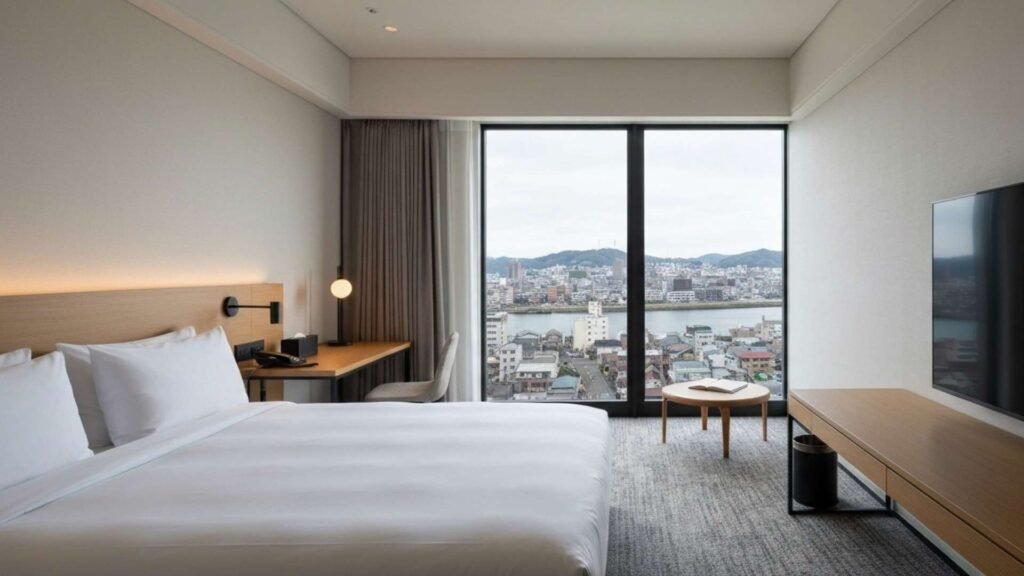
1. Luxury and Scenic Stays
3. Budget-Friendly & Traditional Stays
- Address: 1-1-7 Iwakuni, Iwakuni-shi, Yamaguchi-ken 741-0062, Japan
- Location: Right beside Kintaikyō Bridge on the Nishiki River.
- Access:
- About 20 minutes by bus from JR Iwakuni Station.
- Around 15 minutes by taxi.
- Highlights: Rooms with bridge views, traditional Japanese onsen baths, Kaiseki-style cuisine.
2. Modern & Convenient Options
🏨 Green Rich Hotel Iwakuni Ekimae
- Address: 2-5-21 Marifumachi, Iwakuni-shi, Yamaguchi-ken 740-0018, Japan
- Location: Directly across from JR Iwakuni Station.
- Access:
- Just a 2-minute walk from the station.
- About 15–20 minutes by bus to Kintaikyō Bridge.
- Highlights: Comfortable modern rooms, family-friendly breakfast, easy access for train travelers.
🏨 Hotel Trend Iwakuni
- Address: 4-14-21 Marifumachi, Iwakuni-shi, Yamaguchi-ken 740-0018, Japan
- Location: 5 minutes’ walk from JR Iwakuni Station.
- Access:
- Convenient for city center exploration.
- About 20 minutes by bus to Kintaikyō Bridge.
- Highlights: Practical choice in the city center, great for both leisure and business trips.
3. Budget-Friendly & Traditional Stays
🏯 Hashimoto Ryokan (橋本旅館)
- Address: Yokoyama 2-16-2, Iwakuni-shi, Yamaguchi-ken 741-0081, Japan
- Location: Within walking distance of Kintaikyō Bridge.
- Access:
- Around 15 minutes by bus from JR Iwakuni Station.
- Just 5 minutes on foot to Kintaikyō Bridge.
- Highlights: Family-run ryokan with tatami rooms, traditional hospitality, and affordable prices.
4. Nearby Alternatives in Hiroshima
Since Iwakuni is a smaller city, some travelers prefer to stay in Hiroshima and visit Iwakuni as a day trip.
🏨 Example: Sheraton Grand Hiroshima Hotel
- Address: 12-1 Wakakusa-cho, Higashi-ku, Hiroshima-shi, Hiroshima-ken, Japan
- Access: About 45 minutes by train (JR Sanyo Main Line) from Hiroshima Station to Iwakuni Station. JR Pass is valid.
- Advantage: Wider hotel selection, big-city comfort, and easy day-trip access to Iwakuni.
🚉 How to Get to Iwakuni Castle & Kintaikyō Bridge
1. From Hiroshima to Iwakuni:
- Take the JR Sanyo Main Line (45 minutes).
- Covered by the Japan Rail Pass.
2 From Iwakuni Station to Kintaikyō Bridge:
- 15–20 minutes by bus from the station.
- About 15 minutes by taxi.
3. From Kintaikyō Bridge to Iwakuni Castle:
- Cross the bridge and walk to the Ropeway Station.
- Take the ropeway (5 minutes) to the top of Mount Shiroyama.
- From there, it’s about a 10-minute walk to the castle entrance.
Practical Information for Visiting Iwakuni Castle
- Comfortable Shoes: The castle grounds involve walking uphill and along stone paths.
- Local Cuisine: Don’t miss Iwakuni Sushi, a unique layered sushi pressed into square shapes—quite different from what most international visitors imagine sushi to be.
- Timing: A combined ticket for the ropeway, castle, and Kintaikyō Bridge is the most convenient and economical option.
- Opening Hours: Typically 9:00 AM – 4:00 or 5:00 PM (varies by season).
- Tickets: A combined ticket is available that includes entry to Kintaikyō Bridge, the ropeway, and the castle (highly recommended for convenience).
- Photography is welcome, especially from the observation deck, but be respectful of museum rules inside.
Best Time to Visit:
- Spring (late March – early April): Cherry blossoms create a magical setting.
- Autumn (late October – November): Brilliant autumn foliage surrounds the castle.
- Summer evenings: The illuminated bridge and castle create a romantic atmosphere.
Final Thoughts
Visiting Iwakuni Castle is more than a simple sightseeing stop—it’s an immersion into Japan’s feudal history, natural beauty, and living traditions. From the ropeway ride through the forests to the samurai artifacts inside, from the panoramic deck views to the stroll across Kintaikyō Bridge, each moment connects the past with the present.
For those traveling in western Japan, whether on a day trip from Hiroshima or as part of a Yamaguchi adventure, Iwakuni Castle is an unforgettable highlight that blends culture, history, and scenery in perfect harmony.

